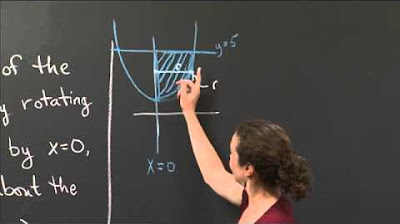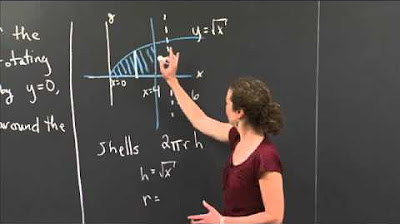Trig Integrals and a Volume of Revolution | MIT 18.01SC Single Variable Calculus, Fall 2010
TLDRIn this educational video, Professor Joel Lewis guides students through a trigonometric integration problem to find the volume of a solid formed by revolving the curve y = sin(ax) around the x-axis. He suggests using the disk method, sets up the integral, and employs a substitution to simplify the problem. The solution involves applying a half-angle trigonometric identity to transform the integral into a more manageable form, ultimately leading to the volume formula of the solid, which is pi squared over 2a.
Takeaways
- 📚 The video is a recitation session focused on solving a trigonometric integration problem.
- 📐 The problem involves finding the volume of a solid formed by revolving the curve y = sin(ax) between two consecutive roots around the x-axis.
- 🏈 The solid created has a shape that is described as 'vaguely football-shaped'.
- 🔍 The method of integration chosen for the problem is the disk method with vertical rectangles.
- 📉 The region of integration starts at x = 0 and ends when sin(ax) = 0, which is at x = π/a.
- 📝 The volume element dV for the disk method is given by π * (sin(ax))^2 * dx.
- 🧩 The integral to find the volume V is set up as an integral from 0 to π/a of π * (sin(ax))^2 dx.
- 🔄 A u-substitution is used to simplify the integral, with u = ax and du = a*dx, or dx = 1/a du.
- 🔢 The integral simplifies to π/a times the integral from 0 to π of (1 - cos(2u))/2 du.
- 📉 The half-angle identity is used to transform the sine squared term into a form involving cosine, which is easier to integrate.
- ✅ The final volume of the solid is found to be π^2/(2a) after integrating and evaluating the expression.
Q & A
What is the main topic discussed in the video script?
-The main topic discussed in the video script is the computation of the volume of a solid formed by revolving the curve y = sin(ax) around the x-axis.
What shape does revolving the curve y = sin(ax) around the x-axis create?
-Revolving the curve y = sin(ax) around the x-axis creates a solid that is vaguely football-shaped.
What method of integration is suggested for solving the volume of the solid?
-The method of integration suggested for solving the volume of the solid is using vertical rectangles, which are equivalent to integrating disks.
What is the range of x for the integration?
-The range of x for the integration is from 0 to π/a, where a is the coefficient of x in the sine function.
What is the volume element dV for the disk method?
-The volume element dV for the disk method is π times the sine squared of ax, multiplied by dx.
What substitution is used to simplify the integral?
-The substitution used to simplify the integral is u = ax, which leads to dx = 1/a du.
What trigonometric identity is used to simplify the sine squared term in the integral?
-The trigonometric identity used to simplify the sine squared term is the half-angle identity: sine squared u = (1 - cosine(2u))/2.
What is the final integral expression after applying the trigonometric identity?
-The final integral expression after applying the trigonometric identity is π/a times the integral from 0 to π of (1 - cosine(2u))/2 du.
How is the integral of cosine(2u) over the interval [0, π] evaluated?
-The integral of cosine(2u) over the interval [0, π] is evaluated as -sine(2u)/4, considering the derivative of sine is cosine.
What is the final answer for the volume of the solid?
-The final answer for the volume of the solid is π^2/(2a).
What is the significance of using half-angle identities in this context?
-The significance of using half-angle identities in this context is to simplify the integral by reducing the even powers of sine to a form that can be easily integrated.
Outlines
📚 Introduction to Trigonometric Integration Problem
In this introductory paragraph, Joel Lewis welcomes students back to a recitation session focused on trigonometric integration. He presents a problem involving the computation of the volume of a solid formed by revolving one hump of the curve y = sin(ax) around the x-axis. This solid is described as having a football-like shape. The students are encouraged to pause the video to attempt the problem before rejoining the session for a collaborative solution. The paragraph sets the stage for the application of standard methods in computing the volume of solids of rotation, emphasizing the importance of understanding the region of integration and choosing the appropriate method, in this case, revolving vertical disks.
🔍 Detailed Solution for Volume of Solid of Revolution
This paragraph delves into the detailed process of solving the volume of the solid of revolution problem introduced earlier. The method of integration chosen is through vertical rectangles, which are visualized as spinning into vertical disks. The region of integration is determined by the points where the sine function equals zero, leading to the identification of the limits of integration from 0 to π/a. The element of volume, dV, is expressed as π times the sine squared of ax, multiplied by dx. A substitution method is employed to simplify the integral, setting u = ax, which transforms the integral into a more manageable form involving sine squared of u. The paragraph then introduces a trigonometric identity to further simplify the integral, replacing sine squared u with 1 - cosine(2u)/2. The integral is then solved by integrating the simplified expression, resulting in the final volume of the solid being pi squared over 2a. The summary concludes by highlighting the use of half-angle formulas in trigonometric integrals and the simplification process that leads to an easy-to-compute integral.
Mindmap
Keywords
💡Trig Integration
💡Volume of Solid
💡Sine Function
💡Roots
💡Solid of Rotation
💡Disk Method
💡Element of Volume
💡U-Substitution
💡Trig Identities
💡Definite Integral
💡Half-Angle Identity
Highlights
Introduction to the problem of calculating the volume of a solid formed by revolving the curve y = sin(ax) around the x-axis.
Explanation of the region of integration and the choice between shells with horizontal rectangles or disks with vertical rectangles.
Decision to use vertical rectangles (disks) for the integration method due to the simplicity of the setup.
Identification of the end of the region for integration as the point where sin(ax) equals zero, which is at x = π/a.
Description of the volume element dV as pi times sine squared of ax times dx.
Setting up the integral for the volume V as an integral from 0 to π/a of pi times sine squared of ax dx.
Suggestion to simplify the integral by using a u-substitution to eliminate a*x.
Transformation of the integral using u = a*x and dx = 1/a du, simplifying the limits of integration to 0 to π.
Application of the half-angle identity to rewrite sine squared u as (1 - cos(2u))/2.
Integration of the simplified expression to find the volume, resulting in pi/a times the integral from 0 to π of (1 - cos(2u))/2 du.
Solution of the integral by finding the antiderivative and evaluating it at the limits of integration.
Final calculation of the volume as pi squared over 2a, after evaluating the antiderivative at the bounds.
Recap of the method used to compute the volume of the solid of revolution, emphasizing the use of trigonometric identities.
Discussion on the importance of using half-angle formulas when both sine and cosine appear to an even power in a trigonometric integral.
Explanation of the simplification process that reduces the integral to a form where sine or cosine appears to an odd power, making it easier to integrate.
Conclusion of the video with the final answer for the volume and a summary of the steps taken to arrive at the solution.
Transcripts
Browse More Related Video

Volume of a Paraboloid via Disks | MIT 18.01SC Single Variable Calculus, Fall 2010

Calculus 1: Shell Method Examples

Volume of Revolution via Shells | MIT 18.01SC Single Variable Calculus, Fall 2010

2011 Calculus AB free response #3 (c) | AP Calculus AB | Khan Academy

Volumes with Disks

2022 AP Calculus BC Exam FRQ #5
5.0 / 5 (0 votes)
Thanks for rating: